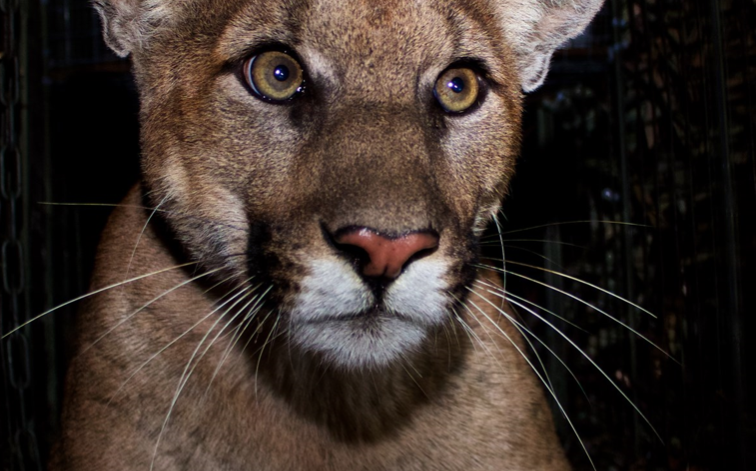CommentsDEEGAN ON LA-The dog eat dog world for survival was upended a few weeks ago when it became cat versus cat, followed by cat versus car on the 405 freeway.
Technology--a GPS embedded collar worn by the mountain lion known as P-61 (photo above), and a video surveillance camera--provided a tracking shot of P-61 being stalked by another mountain lion in a scene that is worthy of Hollywood.
The National Parks Service, which monitors the collared big cats, reported that P-61 was in a confrontation with another mountain lion in the Bel Air vicinity, between Bel Air Crest Road and the Sepulveda Boulevard underpass, in the early hours of September 7, 2019. The drama, which was captured on video, played out between 3:09 a.m. when the chase began and 4:00 a.m. when P-61 was struck and killed by a southbound car on the 405 freeway. He had managed to make it across five of the 10 freeway lanes.
It was not the first time P-61 had crossed the busy LA freeway. Several weeks before his death, the cat had successfully crossed the same freeway from the opposite direction.
Those who study the behavior of our mountain lion population say that the genesis of this tragedy, within a short range of the tony Bel Air neighborhood, may have been a territorial dispute.
Mansions and mountain lions are not part of a realtor's pitch line, although wealthy residents and the starving, lonely big cats do cohabit the same environment. Our mountain lion population lives mainly in the Santa Monica Mountains range from Griffith Park westward to the ocean, in small territorial patches hemmed in by freeways and housing.
Many pumas have been caught, tagged with GPS collars by the California Department of Fish and Wildlife (CDFW) and released back into the wild. Complementing the collars is a network of stationary cameras that has captured pictures of the big cats wandering through the hillsides as they search for what they need in their lives: food, water, shelter, security and a mate that will relieve a lion’s loneliness and enable him to extend a family line.
Unfortunately, because of the restrictions that isolate the cats they sometimes breed with their own cubs. That can result in unhealthy offspring and won’t guarantee preservation of the species in the long run.
Mobility for mountain lions is a key requirement for their survival. Politicos and the private sector are working on solutions.
Attending to the challenge of keeping these cats alive and better connected within their habitat is the goal of the Planning Department’s recently launched Wildlife Habitat and Linkages Pilot Study to “Provide development standards for managing and conserving biological resources by potentially regulating development and wildlife habitats within these areas” (the hills habitat of mountain lions and other wildlife).
A vocal proponent of this study, which touches many of his westside canyon constituents, is Councilmember Paul Koretz (CD5). In the spring he told CityWatch, “The ordinance that the planning team have been strategizing with my staff and scientists, organizations like CLAW and hillside neighborhood groups is hopefully about 12-18 months away. That would be approximately next spring or summer.”
"For decades,” said Koretz, “as new home construction has filled in hillside neighborhoods, ancient migratory pathways of native wildlife have been diverted. Remaining gaps of open space have been filled in between wildlife habitats creating bottlenecks that in many instances have permanently corralled wildlife thereby cutting them off from miles of food and separating them from each other.”
Koretz pointed out that “We are at a point where one new home can block miles of habitat. We are considering new building rules particularly that are on the verge of blocking wildlife corridors from biological resources. That may mean putting trees first in the planning checklist and not building lot line to lot line.”
The private sector is helping to create the Liberty Canyon Wildlife Crossing over the ten-lane Ventura Freeway at Liberty Canyon in Agoura Hills. It will “link protected habitat on each side of the freeway together, allowing mountain lions and other wildlife access to green space they need to survive, and will be the largest such crossing in the world,'' says the National Wildlife Federation. They are partnered with the Santa Monica Mountains Fund and many other stakeholders to campaign and fundraise “to protect Southern California’s mountain lions, and to advocate for the critical habitat linkages they require to ensure a healthy future for people, mountain lions and other wildlife in this highly urbanized landscape.”
The tragedy of P-61 is a good reminder that we share a native habitat with a mountain lion population. They are stuck in the middle of an urban sprawl encroaching on what had once been their home, with their routes to food, shelter, and mates shrinking. When lions do get together, and don’t get along, death is often the outcome.
Expanding our consciousness regarding the local mountain lion predicament may be P-61’s most effective and enduring legacy.
(Tim Deegan is a civic activist whose DEEGAN ON LA weekly column about city planning, new urbanism, the environment, and the homeless appear in CityWatch. Tim can be reached at [email protected].) Edited for CityWatch by Linda Abrams.
















